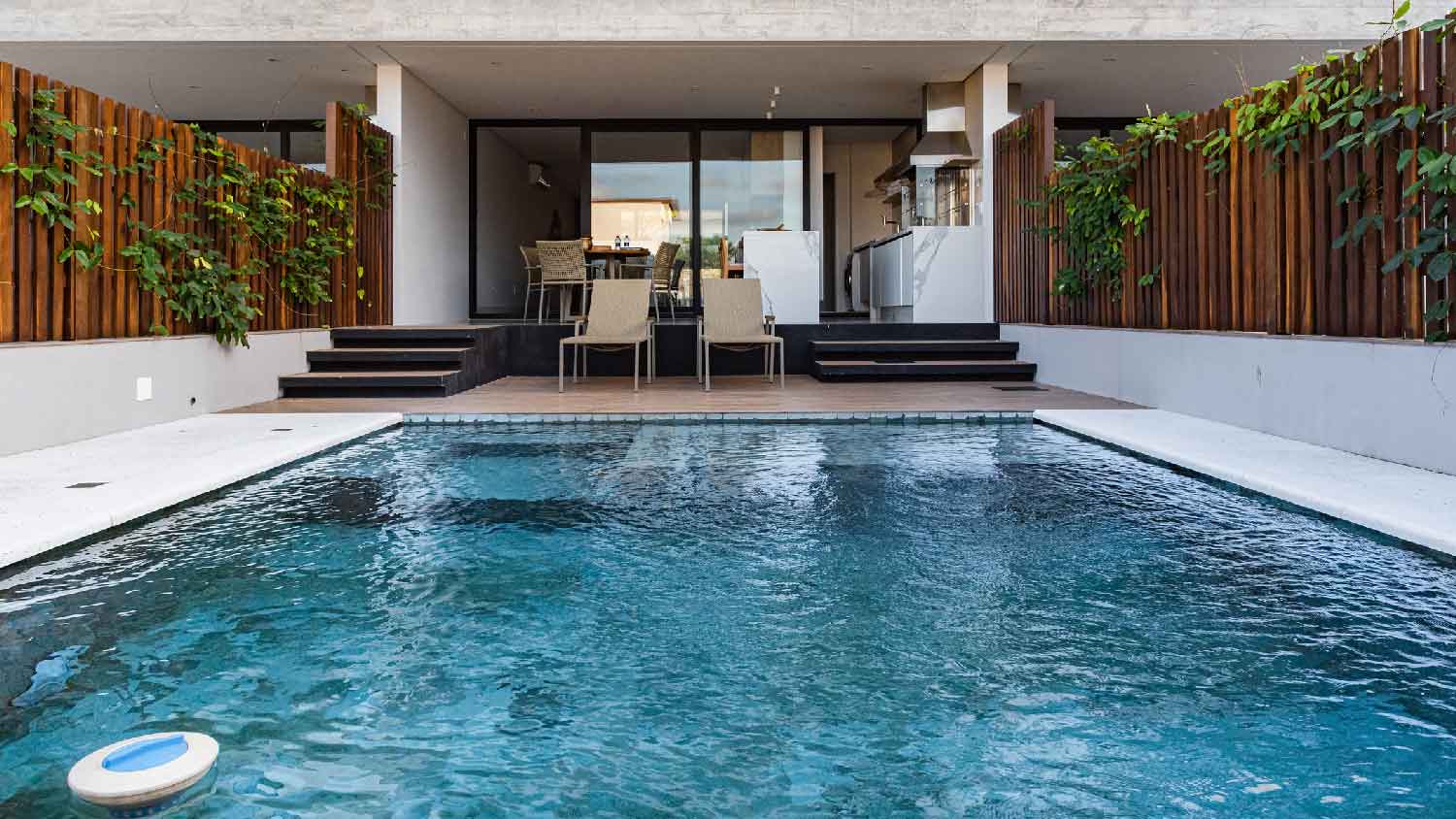
Discover the average hot tub maintenance cost, what impacts pricing, and how to save money. Get expert tips to keep your hot tub running smoothly all year.
Pool and spa servicing costs depend on your project and location. Check with a local pro for your specific job.
Hot tub cover cost varies based on the size, material, and features.
Professional hot tub cover installation costs between $50 to $100 per hour and ensures a proper seal.
Common add-ons, including lifters, locks, and weatherproofing, increase the overall cover cost.
Hot tub cover materials, such as vinyl, aluminum, and foam core, range between $200 and $1,200 on average.
This article was created using automation technology and thoroughly fact-checked and edited by an Angi Editor in accordance with our AI policy.
Hot tub cover costs average around $300, with most homeowners paying between $200 and $1,500 for a new cover. Prices can range from as low as $30 for basic models to over $12,000 for premium or custom options. Costs vary based on size, material, and additional features.
Choosing the right hot tub cover matters for energy savings, spa protection, and peace of mind. We’ll walk through everything that affects cost, so you can make the best decision for your home and budget.
Knowing what drives hot tub cover costs helps you plan your purchase and avoid surprises. Let’s break down the main factors that influence pricing.
There are several types of hot tub covers, each designed for different needs and budgets. Standard soft covers are common and affordable, while hard covers provide better energy efficiency and security. Thermal blanket covers are lightweight but offer less protection, and walk-on or automatic covers deliver premium features at a higher price.
| Cover Type | Cost Range |
|---|---|
| Thermal blanket | $30–$150 |
| Inflatable | $30–$110 |
| Soft | $50–$200 |
| Hard | $250–$1,000 |
| Walk-on | $700–$1,500 |
| Automatic | $2,000–$12,000 |
Standard soft covers are suitable for most homeowners, but those seeking extra insulation or a perfect fit for an unusual spa shape may want to invest in custom-fit options. Automated covers are the most expensive but add convenience and advanced features.
Hot tub cover costs rise with the size and complexity of your spa. Standard-sized covers for round or rectangular tubs are more affordable, while covers for extra-large or irregular-shaped hot tubs require custom fabrication and cost more. The larger the surface area, the more material and labor needed.
| Cover Size | Cost Range |
|---|---|
| Small | $200–$350 |
| Medium | $300–$500 |
| Large | $400–$700 |
| Custom/irregular | $600–$1,500 |
Custom covers for oversized or uniquely shaped spas can reach well above standard pricing, especially if precise measurements and specialty materials are required.
Material choice plays a major role in hot tub cover cost and performance. Vinyl and marine-grade vinyl are common, offering good weather resistance. Aluminum and hybrid covers provide added strength and longevity. Foam core thickness and insulation value (R-value) also impact both cost and energy efficiency.
| Material | Cost Range | |
|---|---|---|
| Vinyl | $200–$500 | Affordable, decent insulation, moderate lifespan |
| Marine-grade vinyl | $300–$700 | Better UV/weather resistance, longer-lasting |
| Aluminum | $600–$1,200 | Very durable, heavy, resists cracking |
| Foam core | $250–$600 | Excellent insulation, lightweight, can absorb water |
| Hybrid | $500–$1,000 | Combines vinyl/aluminum, balances cost/durability |
Thicker and denser foam increases insulation value, which can help lower your energy bills but adds to the upfront cost. Weather resistance, UV protection, and longevity are better in premium materials, making them a smart investment for harsh climates.
Labor is another factor in total hot tub cover cost. Local hot tub installation pros may be necessary for heavy, custom, or automated covers. Hourly rates for installers range from $50 to $100 per hour, or you might see flat installation fees of $100 to $300. Labor costs can be higher in urban areas or regions with higher living expenses.
If your old cover must be removed and disposed of, expect to pay an additional $50 to $100 for this service. Most standard covers can be installed by savvy homeowners, but complex installations are best left to the pros for safety and warranty reasons.
Proper site preparation ensures your new cover fits and functions well. This includes measuring your spa accurately, cleaning the area, and checking for obstructions. Some suppliers charge a delivery fee, which can range from $25 to $75, especially for large or heavy covers.
If your hot tub area needs extra prep—such as leveling, clearing debris, or adjusting hardware—these tasks may add a small amount to your total cost. Accurate measurements are essential to avoid costly mistakes.
Tipping is not required, but it’s a thoughtful way to thank delivery or installation professionals for a job well done. If you choose to tip, $10 to $20 per person or around 5% to 10% of the labor portion is appropriate, especially for complex or heavy installations.
Several additional factors can influence your hot tub cover cost:
Demolition or removal of an old or damaged cover
Post-installation cleanup, if not included in labor
Permits for automated or mechanical covers
Upgrading support structures for heavy or hard covers
Adding cover lifters, safety locks, or enhanced handles
Decorative options, such as custom colors, embroidery, or longer skirts
Each add-on or upgrade increases the overall investment but may offer valuable benefits in convenience, appearance, or protection.
Owning a hot tub cover comes with some ongoing costs beyond the initial purchase. Let’s look at what to expect for maintenance, operation, repairs, and insurance.
Regular hot tub maintenance keeps your hot tub cover in good shape and extends its life. You’ll need to clean the cover with gentle cleaners and apply protectants to prevent UV and weather damage. Expect to spend $20 to $50 per year on cleaning products and conditioners.
Occasional replacement of straps, handles, or minor hardware may cost $10 to $30 each. Annual or seasonal inspections help catch small issues before they become expensive repairs.
A high-quality cover can lower your hot tub’s energy bills by improving insulation and reducing heat loss. Investing in a better-insulated cover may save you $10 to $25 per month in heating costs, especially in colder climates.
Automated or powered covers use a small amount of electricity—on average under $10 per year—but offer convenience and easy operation. The right cover can pay for itself over time by reducing ongoing operating expenses.
Common hot tub cover repairs include patching vinyl tears, replacing foam inserts, or fixing broken handles and hinges. Minor repairs cost, on average, between $30 and $100, while major repairs or foam replacement can reach $150 to $300.
If your cover is badly waterlogged or structurally damaged, replacement is often more cost-effective than repeated repairs. Many covers include warranties that may cover some repair costs, but out-of-pocket expenses are common for normal wear and tear.
Most homeowners insurance policies do not cover routine hot tub cover replacement, but damage from storms or accidents might be included. If you invest in a high-value or custom cover, check with your insurer to see if extra coverage is available for an additional cost.
Some policies require documentation or endorsements for luxury spa accessories. Always review your insurance details to avoid gaps in protection.
You have the option to install a hot tub cover yourself or hire a professional. The best choice depends on your skills, the type of cover, and your budget.
DIY installation can save you $100 to $300 in labor costs. Materials and tools may cost $20 to $50 (for basic hand tools and cleaning supplies). Most standard covers are manageable for two people to lift and position, but heavy or automated covers require special equipment and know-how.
DIY installation requires:
Accurate measuring and alignment
Tools for removing the old cover
Careful handling to avoid damage
Following manufacturer instructions closely
Improper installation can void warranties, cause leaks, or create safety issues. For custom-fit, hard, or automated covers, we recommend hiring a pro to ensure a proper fit and safe operation.
| Installation Type | Materials and Tools | Labor | Total Cost (Cover Not Included) |
|---|---|---|---|
| DIY | $20–$50 | $0 | $20–$50 |
| Professional install | $20–$50 | $100–$300 | $120–$350 |
If your cover is unusually large, heavy, or includes mechanical parts, professional installation is the safest and smartest route.
Add-ons and upgrades can personalize your hot tub cover and boost functionality. Each option comes with its own cost and benefits.
Cover lifters: $100 to $300, make removing and replacing your cover much easier and protect the cover from damage.
Locks and safety straps: $20 to $75, provide added security, especially for families with children or pets.
Upgraded insulation or weatherproofing: $50 to $200, improves energy efficiency and extends the cover’s lifespan.
Custom colors, embroidery, or branding: $50 to $200, adds a personalized touch.
Replacement hardware (handles, hinges): $10 to $50 per piece, useful for quick fixes.
Automated or remote-controlled cover systems: $1,200 to $3,000, offer convenience and ease of use for frequent spa users.
Consider which add-ons match your needs and budget before finalizing your hot tub cover purchase.
You can save money on your next hot tub cover by making smart choices and timing your purchase well:
Shop off-season for discounts and promotions when demand is lower.
Compare multiple quotes from suppliers and installers to find the best value.
Choose standard sizes and materials to avoid custom fabrication fees.
Maintain your cover regularly to extend its lifespan and delay replacement.
Bundle installation with other hot tub services for potential package savings.
Consider local suppliers to reduce shipping or delivery costs.
We recommend weighing upfront savings against long-term durability and energy efficiency to get the most value from your investment.
Home is the most important place on earth, which is why Angi has helped more than 150 million homeowners transform their houses into homes they adore. To help homeowners with their next project, Angi provides readers with the most accurate cost data and upholds strict editorial standards. We extensively research project costs to develop the pricing data you see, so you can make the best decisions for you and your home. We rely on reputable sources, including the U.S. Bureau of Labor Statistics, academic journals, market studies, and interviews with industry experts—all to ensure our prices reflect real-world projects.
Want to help us improve our cost data? Send us a recent project quote to [email protected]. Quotes and personal information will not be shared publicly.
From average costs to expert advice, get all the answers you need to get your job done.

Discover the average hot tub maintenance cost, what impacts pricing, and how to save money. Get expert tips to keep your hot tub running smoothly all year.

Discover how much installing a steam room costs, including average prices, key cost factors, and tips to save on your steam room installation.

Swim spa costs vary, but each unit offers the benefits of a pool and hot tub combined. Use this guide to plan your budget.

If your pool pump is losing prime, you’re likely facing unfiltered, dirty water. Learn why this is happening and what to do about it.

Discover the cost of whirlpool tub installation, including average prices, key cost factors, and tips to help homeowners budget for their project.

When you go for a dip in your pool, it should be refreshing, not slimy. Get answers to "why is my pool slimy" and find out how to fix it.